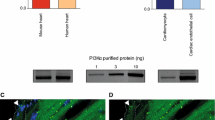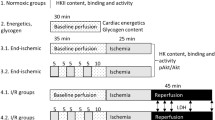Abstract
Activation of the PI3K/Akt pathway protects the heart from ischemia-reperfusion injury (IRI). The phosphatase PTEN is the main negative regulator of this pathway. We hypothesized that reduced PTEN levels could protect against IRI. Isolated perfused mouse hearts from PTEN+/− and their littermates PTEN+/+ (WT), were subjected to 35 min global ischemia and 30 min reperfusion, with and without 2, 4 or 6 cycles ischemic preconditioning (IPC). The end point was infarct size, expressed as a percentage of the myocardium at risk (I/R%). PTEN and Akt levels were determined using Western blot analysis. Unexpectedly, there were no significant differences in infarction between PTEN+/− and WT (42.1 ± 5.0% Vs. 45.6 ± 3.3%). However, the preconditioning threshold was significantly reduced in the PTEN+/− Vs. WT, with 4 cycles of IPC being sufficient to reduce I/R%, compared to 6 cycles in the WT (4 cycles IPC: 29.8. ± 3.69% in PTEN+/− Vs. 45.5. ± 5.08% in WT, P < 0.01). In addition, the ratio between the phospho/total Akt (Ser473 and Thr308) was slightly but significantly increased in the PTEN+/− indicating an upregulation of PI3K/Akt pathway. Interestingly, the levels of the other phosphatases that may negatively regulate the PI3K/Akt pathway (PP2A, SHIP2 and PHLPP) were not significantly different between littermates and PTEN+/−. In conclusion, PTEN haploinsufficiency alone does not induce cardioprotection in this model; however, it reduces the threshold of protection induced by IPC.







Similar content being viewed by others
References
Backers K, Blero D, Paternotte N, Zhang J, Erneux C (2003) The termination of PI3K signalling by SHIP1 and SHIP2 inositol 5-phosphatases. Adv Enzyme Regul 43:15–28
Bell RM, Yellon DM (2003) Bradykinin limits infarction when administered as an adjunct to reperfusion in mouse heart: the role of PI3K, Akt and eNOS. J Mol Cell Cardiol 35(2):185–193
Bhamra GS, Hausenloy DJ, Davidson SM, Carr RD, Paiva M, Wynne AM, Mocanu MM, Yellon DM (2008) Metformin protects the ischemic heart by the Akt-mediated inhibition of mitochondrial permeability transition pore opening. Basic Res Cardiol 103:274–284
Bullard AJ, Yellon DM (2005) Chronic erythropoietin treatment limits infarct-size in the myocardium in vitro. Cardiovasc Drugs Ther 19:333–336
Cai Z, Semenza GL (2005) PTEN activity is modulated during ischemia and reperfusion: involvement in the induction and decay of preconditioning. Circ Res 97:1351–1359
Crackower MA, Oudit GY, Kozieradzki I, Sarao R, Sun H, Sasaki T, Hirsch E, Suzuki A, Shioi T, Irie-Sasaki J, Sah R, Cheng HY, Rybin VO, Lembo G, Fratta L, Oliveira-dos-Santos AJ, Benovic JL, Kahn CR, Izumo S, Steinberg SF, Wymann MP, Backx PH, Penninger JM (2002) Regulation of myocardial contractility and cell size by distinct PI3K-PTEN signaling pathways. Cell 110:737–749
Gao T, Furnari F, Newton AC (2005) PHLPP: a phosphatase that directly dephosphorylates Akt, promotes apoptosis, and suppresses tumor growth. Mol Cell 18:13–24
Hausenloy DJ, Mocanu MM, Yellon DM (2004) Cross-talk between the survival kinases during early reperfusion: its contribution to ischemic preconditioning. Cardiovasc Res 63:305–312
Hausenloy DJ, Wynne AM, Yellon DM (2007) Ischemic preconditioning targets the reperfusion phase. Basic Res Cardiol 102:445–452
Hausenloy DJ, Yellon DM (2004) New directions for protecting the heart against ischaemia-reperfusion injury: targeting the reperfusion injury salvage kinase (RISK)-pathway. Cardiovasc Res 61:448–460
Ishihara H, Sasaoka T, Kagawa S, Murakami S, Fukui K, Kawagishi Y, Yamazaki K, Sato A, Iwata M, Urakaze M, Ishiki M, Wada T, Yaguchi S, Tsuneki H, Kimura I, Kobayashi M (2003) Association of the polymorphisms in the 5′-untranslated region of PTEN gene with type 2 diabetes in a Japanese population. FEBS Lett 554:450–454
Kane LP, Weiss A (2003) The PI-3 kinase/Akt pathway and T cell activation: pleiotropic pathways downstream of PIP3. Immunol Rev 192:7–20
Lee JO, Yang H, Georgescu MM, Di Cristofano A, Maehama T, Shi Y, Dixon JE, Pandolfi P, Pavletich NP (1999) Crystal structure of the PTEN tumor suppressor: implications for its phosphoinositide phosphatase activity and membrane association. Cell 99:323–334
Maehama T, Dixon JE (1998) The tumor suppressor, PTEN/MMAC1, dephosphorylates the lipid second messenger, phosphatidylinositol 3,4,5-trisphosphate. J Biol Chem 273:13375–13378
Mensah K, Mocanu MM, Yellon DM (2005) Failure to protect the myocardium against ischemia/reperfusion injury after chronic atorvastatin treatment is recaptured by acute atorvastatin treatment: a potential role for phosphatase and tensin homolog deleted on chromosome ten? J Am College Cardiol 45:1287–1291
Miki T, Miura T, Tanno M, Nishihara M, Naitoh K, Sato T, Takahashi A,Shimamoto K (2007) Impairment of cardioprotective PI3K-Akt signaling by post-infarct ventricular remodeling is compensated by an ERK-mediated pathway. Basic Res Cardiol 102:163–170
Mocanu MM, Bell RM, Yellon DM (2002) PI3 kinase and not p42/p44 appears to be implicated in the protection conferred by ischemic preconditioning. J Mol Cell Cardiol 34:661–668
Mocanu MM, Field DC, Yellon DM (2006) A potential role for PTEN in the diabetic heart. Cardiovasc Drugs Ther 20:319–321
Mocanu MM, Yellon DM (2007) PTEN, the Achilles’ heel of myocardial ischemia/reperfusion injury? Br J Pharmacol 150:833–838
Ning K, Miller LC, Laidlaw HA, Burgess LA, Perera NM, Downes CP, Leslie NR, Ashford ML (2006) A novel leptin signalling pathway via PTEN inhibition in hypothalamic cell lines and pancreatic beta-cells. EMBO J 25:2377–2387
Philipp S, Critz SD, Cui L, Solodushko V, Cohen MV, Downey JM (2006) Localizing extracellular signal-regulated kinase (ERK) in pharmacologica preconditioning’s trigger pathway. Basic Res Cardiol 101:159–167
Podsypanina K, Ellenson LH, Nemes A, Gu J, Tamura M, Yamada KM, Cordon-Cardo C, Catoretti G, Fisher PE, Parsons R (1999) Mutation of Pten/Mmac1 in mice causes neoplasia in multiple organ systems. Proc Natl Acad Sci USA 96:1563–1568
Schmid AC, Byrne RD, Vilar R, Woscholski R (2004) Bisperoxovanadium compounds are potent PTEN inhibitors. FEBS Lett 566:35–38
Simpkin JC, Yellon DM, Davidson SM, Lim SY, Wynne AM, Smith CC (2007) Apelin-13 and apelin-36 exhibit direct cardioprotective activity against ischemiareperfusion injury. Basic Res Cardiol 102:518–528
Smith CCT, Mocanu MM, Davidson SM, Wynne AM, Simpkin JC, Yellon DM (2006) Leptin, the obesity-associated hormone, exhibits direct cardioprotective effects. Br J Pharmacol 149:5–13
Torres J, Pulido R (2001) The tumor suppressor PTEN is phosphorylated by the protein kinase CK2 at its C terminus. Implications for PTEN stability to proteasome-mediated degradation. J Biol Chem 276:993–998
Tsang A, Hausenloy DJ, Mocanu MM, Carr RD, Yellon DM (2005) Preconditioning the diabetic heart: the importance of Akt phosphorylation. Diabetes 54:2360–2364
Wang H, Douglas W, Lia M, Edelmann W, Kucherlapati R, Podsypanina K, Parsons R, Ellenson LH (2002) DNA mismatch repair deficiency accelerates endometrial tumorigenesis in Pten heterozygous mice. Am J Pathol 160:1481–1486
Wong JT, Kim PT, Peacock JW, Yau TY, Mui AL, Chung SW, Sossi V, Doudet D, Green D, Ruth TJ, Parsons R, Verchere CB, Ong CJ (2007) Pten (phosphatase and tensin homologue gene) haploinsufficiency promotes insulin hypersensitivity. Diabetologia 50:395–403
Wu DN, Pei DS, Wang Q, Zhang GY (2006) Down-regulation of PTEN by sodium orthovanadate inhibits ASK1 activation via PI3-K/Akt during cerebral ischemia in rat hippocampus. Neurosci Lett 404:98–102
Yellon DM, Hausenloy DJ (2005) Realizing the clinical potential of ischemic preconditioning and postconditioning. Nat Clin Pract Cardiovasc Med 2:568–575
Zuluaga S, Alvarez-Barrientos A, Gutierrez-Uzquiza A, Benito M, Nebreda AR, Porras A (2007) Negative regulation of Akt activity by p38[alpha] MAP kinase in cardiomyocytes involves membrane localization of PP2A through interaction with caveolin-1. Cell Signal 19:62–74
Acknowledgments
We thank Professor Ramon Parsons and Professor Dario Alessi for their generous gift of the PTEN+/− mouse model. For breeding advice we would like to thank Gail Fraser from Dundee University and Richard Pugh from UCL. We thank British Heart Foundation for providing the funding for this research.
Author information
Authors and Affiliations
Corresponding author
Additional information
Returned for 1. Revision: 29 November 2007 1. Revision received: 5 May 2008
Returned for 2. Revision: 2 June 2008 2. Revision received: 5 June 2008
Rights and permissions
About this article
Cite this article
Siddall, H.K., Warrell, C.E., Yellon, D.M. et al. Ischemia-reperfusion injury and cardioprotection: investigating PTEN, the phosphatase that negatively regulates PI3K, using a congenital model of PTEN haploinsufficiency. Basic Res Cardiol 103, 560–568 (2008). https://doi.org/10.1007/s00395-008-0735-y
Received:
Accepted:
Published:
Issue Date:
DOI: https://doi.org/10.1007/s00395-008-0735-y




